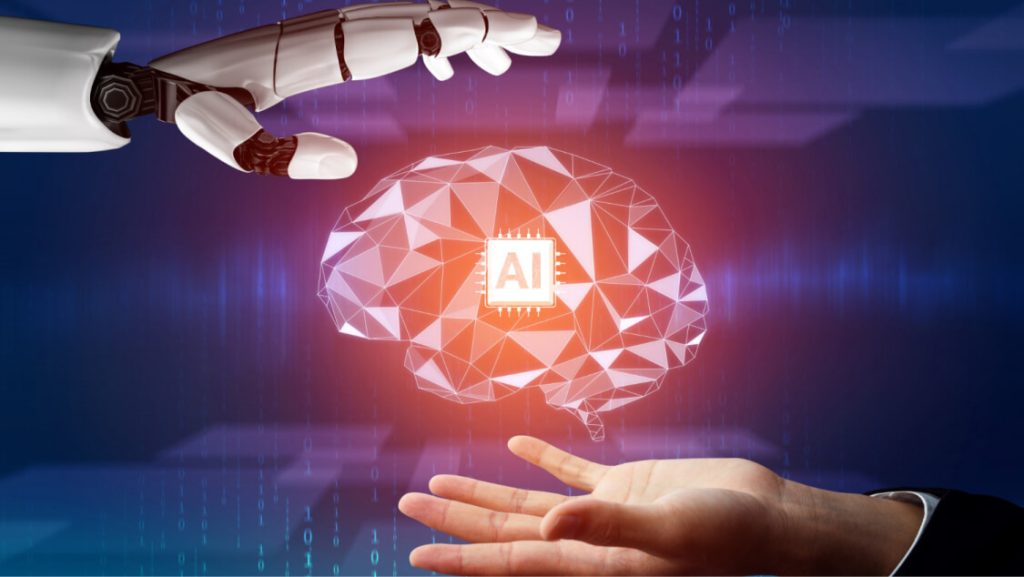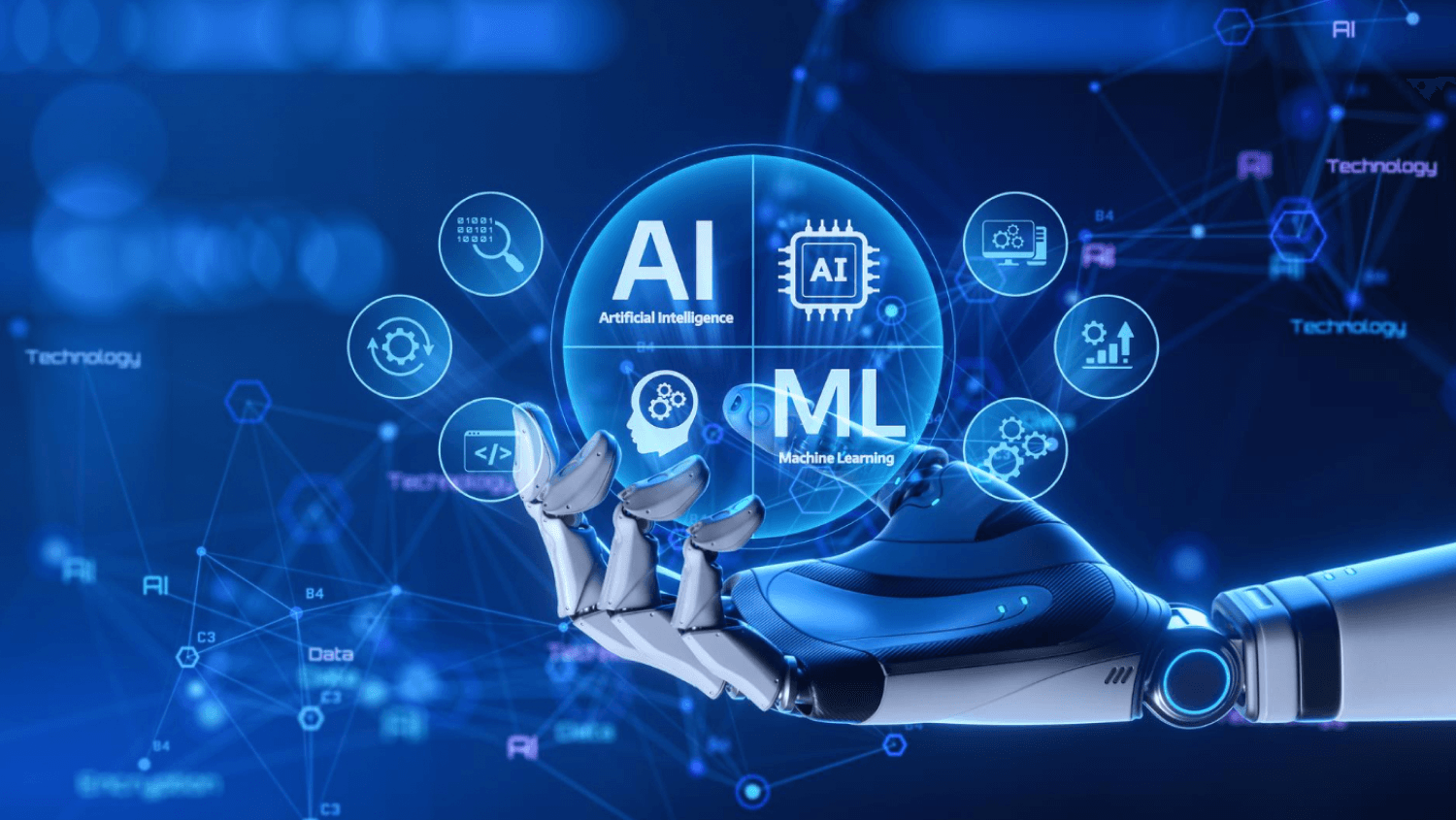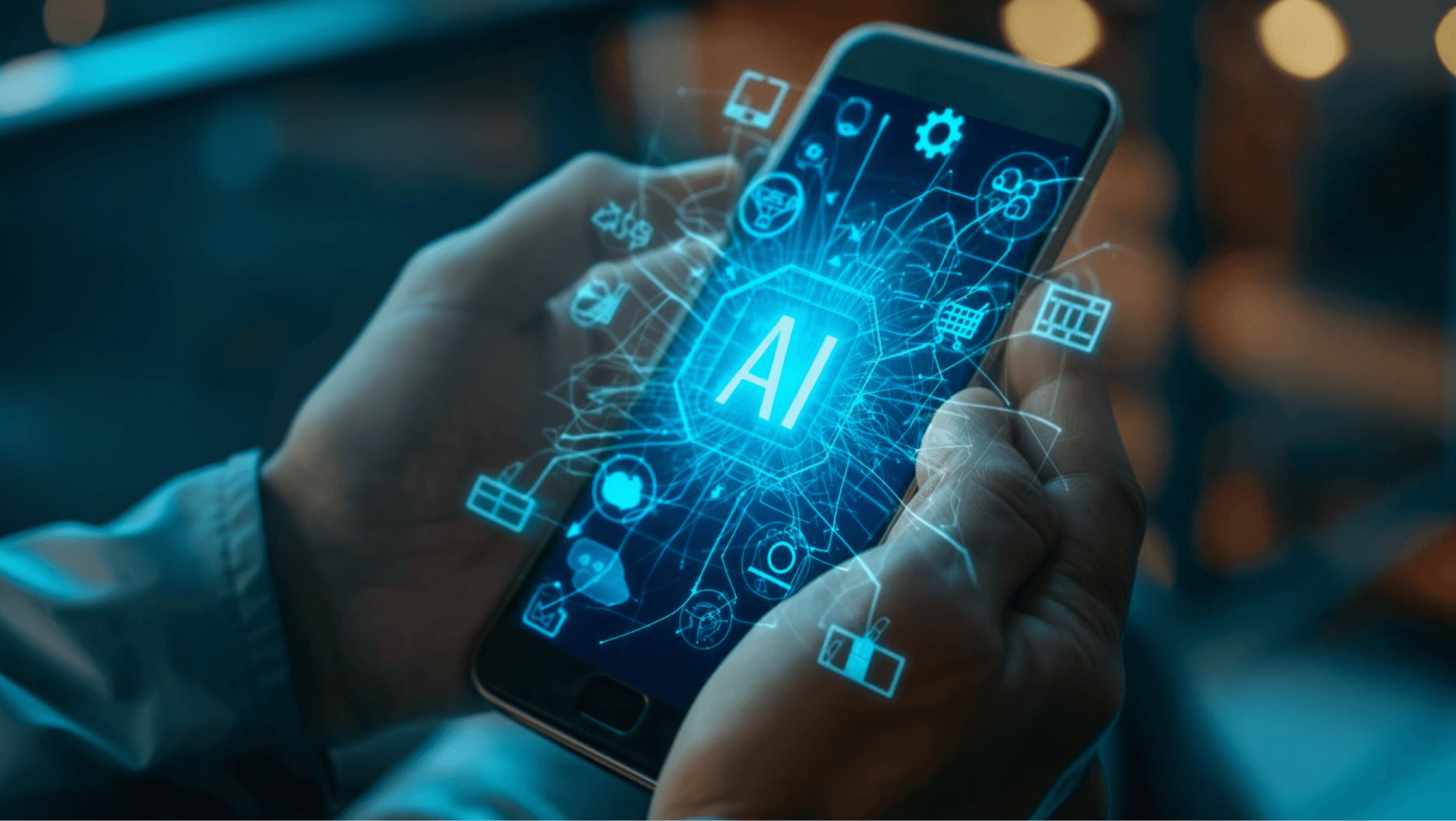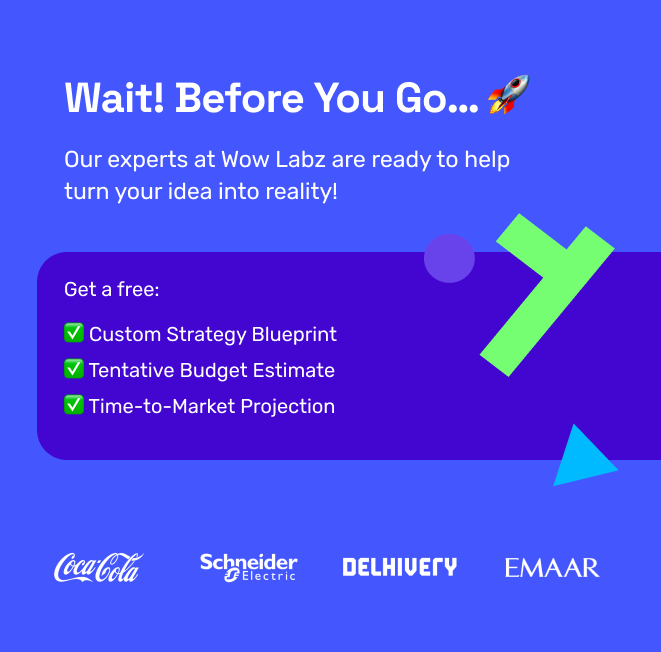Generative AI adoption is no longer just a trend—it’s a revolution, much like the introduction of the personal computer or the internet. As a potentially transformative workplace technology, generative artificial intelligence is reshaping industries, from advertising to healthcare, and beyond. The numbers don’t lie: a recent survey found that usage rates of generative AI tools among businesses have surged by over 200% in the last year alone.
This rapid adoption is creating a ripple effect across all the industries. Companies embracing AI transformation are already outpacing their peers in efficiency, creativity, and innovation. But with such widespread adoption comes challenges, like safeguarding intellectual property and integrating AI with other technologies seamlessly.
For creative agencies, understanding best practices for this new technology is crucial—not just to stay relevant but to lead. In this guide, we’ll look into how you can harness generative AI to amplify your creativity, streamline workflows, and stay ahead in a rapidly evolving market.
Understanding the Role of Generative AI in Advertising
Imagine a tool that can help you brainstorm ideas, craft catchy slogans, or even personalize a campaign for an audience of millions—all in a matter of minutes.
At its core, generative AI is a technology that uses advanced algorithms to create content. Whether it’s text, images, videos, or even music, AI can generate assets based on the input you provide.
It’s not here to replace creativity. It’s here to enhance it. Generative AI handles the grunt work so your team can focus on the big ideas and storytelling.
Potential Applications for Ad Agencies
Generative AI can do a lot, but let’s zoom in on the areas where it can make a real difference for creative agencies:
- Content Creation: Need a dozen catchy taglines for a campaign? Or maybe a social media post that fits a brand’s unique tone? AI tools like ChatGPT or Jasper can whip up these drafts in no time.
- Personalization at Scale: Picture this: you’re running a campaign targeting five different audience segments, and each requires a unique tone and message. Generative AI can adapt the same core idea into customized ads for each segment, making your campaigns hyper-targeted without burning out your team.
- Conceptual Brainstorming: Stuck in a creative rut? AI can spit out hundreds of concepts based on just a few prompts. It’s not about the AI being “better” than your creative team; it’s about having an endless source of inspiration to kickstart brainstorming sessions.
Best practices for successful generative AI adoption
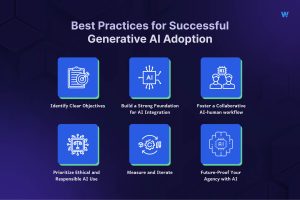
1.Identify Clear Objectives
When it comes to adopting generative AI in your ad agency, the first rule is to know what you’re aiming for. You can’t just throw AI into your workflow and hope for magic—it needs direction.
You need clear objectives that align with your agency’s goals, or you’ll end up with flashy tech that doesn’t actually move the needle.
Align AI with Business Goals
Let’s be real—adopting AI is not about hopping on the latest trend; it’s about results. Start by asking yourself: What are we trying to achieve? Maybe it’s:
- Faster Campaign Turnarounds: AI can speed up content creation, from ad copy to visual concepts, cutting production time in half.
- Increased Engagement Rates: Use AI for hyper-personalized campaigns that hit closer to home for your audience. Think dynamic ads that adapt based on user behavior or preferences.
- Cost Efficiency: Automate repetitive tasks like resizing banners for multiple platforms or generating bulk social media posts, so your team spends less time on busywork and more on strategy.
Focus on Creative Augmentation
Here’s the thing: AI isn’t here to take over; it’s here to team up. Generative AI is like the ultimate brainstorming partner—always ready with ideas but never stealing your spotlight.
- Enhancing Creativity: Let’s say you’re working on a campaign for a brand launch. AI can generate 20 headline ideas in seconds. Some might be mediocre, but others could spark concepts you wouldn’t have considered otherwise. It’s like having a second (digital) opinion.
- Freeing Up Talent: By handling repetitive or mundane tasks, AI lets your creatives focus on what they do best—crafting compelling stories and innovative concepts.
- Maintaining the Human Touch: Remember, the emotional resonance of an ad comes from people, not machines. AI gives you the tools; you decide how to use them to make an impact.
2.Build a Strong Foundation for AI Integration
Alright, so you’ve set your objectives and are ready to dive into the world of generative AI. But before you hit the ground running, let’s talk about setting up a solid foundation.
Invest in the Right Tools
Not all AI tools are created equal, and not every platform will fit your agency’s unique needs. When choosing an AI solution, ask yourself:
- What’s the end goal? Are you looking to streamline ad copy generation, create visuals, or personalize campaigns?
- Is it user-friendly? Your team shouldn’t need a Ph.D. in computer science to use it.
- Does it integrate seamlessly? The tool should fit into your existing workflow, working with platforms like Adobe Creative Suite, Google Ads, or your CRM.
To make the most of generative AI, it’s crucial to know which models will best serve your business needs. We’ve curated a blog detailing the top generative AI models, so you can discover the right tools for tasks like text generation, image creation, and workflow automation.
Check it out and see how these models can transform your operations.
Team Training
This is where the magic happens—equipping your team to collaborate effectively with AI. The technology is great, but it won’t work if your team doesn’t know how to use it.
- Workshops and Training Sessions: Host sessions to teach employees how to use the tools and understand their potential.
- Assign AI Champions: Identify tech-savvy team members to act as go-to experts for troubleshooting and experimentation.
- Encourage Experimentation: Give your team the freedom to play around with AI tools and explore creative ways to integrate them into projects.
3.Foster a Collaborative AI-Human Workflow
Generative AI shines the brightest when it works hand-in-hand with human creativity. Let’s talk about how to set up this collaboration so you can unlock the full potential of both.
Creative Collaboration
Think of AI as your brainstorming buddy—it’s great at generating ideas, but it’s up to your team to fine-tune and give them heart.
- Use AI to kickstart the creative process. Whether it’s drafting headlines, generating visual concepts, or suggesting campaign themes, AI can churn out ideas at lightning speed.
- Human touch is what brings emotional resonance. Your team can refine the AI’s suggestions, adding context, storytelling, and the nuances that connect with your audience.
Feedback Loops
AI learns and improves when you give it feedback. This is where your team’s expertise comes in.
- Review and Revise: After AI generates output, evaluate it critically. What works? What doesn’t?
- Iterative Refinement: Provide feedback directly to the tool (if it supports learning) or adjust prompts and datasets to guide better results next time.
- Collaboration Tools: Use platforms that allow seamless integration of human reviews, like tools with built-in editing or annotation features.
By iterating together, your AI becomes smarter, and your outputs get sharper over time.
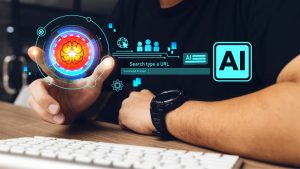
4.Prioritize Ethical and Responsible AI Use
AI is powerful, but with great power comes great responsibility. When using generative AI, especially in the advertising space, ethics and transparency can’t be an afterthought.
Misusing AI can erode trust and harm your agency’s reputation. So, how do you integrate AI responsibly? Let’s break it down.
Transparency
First things first: always be upfront about the role AI plays in your content creation process. Whether it’s a client pitch, a campaign asset, or even internal brainstorming, transparency builds trust.
- Disclose AI Involvement: If a slogan or visual was AI-generated, let clients and stakeholders know. This isn’t about downplaying your team’s role but showcasing how you’re leveraging cutting-edge tools to enhance creativity.
- Educate Clients: Explain how AI complements human efforts. Make it clear that while AI contributes speed and efficiency, the emotional and strategic depth comes from your team.
When audiences or clients know you’re using AI ethically, it positions your agency as forward-thinking and trustworthy.
Bias Mitigation
AI is only as unbiased as the data it’s trained on—and let’s face it, no dataset is perfect. The last thing you want is for an AI-generated ad to unintentionally reflect stereotypes or exclusion.
- Regular Audits: Review AI-generated content for biases in language, imagery, or targeting.
- Diverse Datasets: Train AI models with data that represents a wide range of demographics, perspectives, and cultural contexts.
- Human Oversight: Always have someone on your team vet AI outputs. Machines don’t understand context or nuance the way people do.
Addressing bias and ensuring fairness in generative AI models is crucial for creating ethical and reliable systems. If you’re concerned about how to navigate these challenges, we’ve curated an insightful blog that explores the best practices for managing bias in AI.
5.Measure and Iterate
So, you’ve integrated generative AI into your workflow—great start! But how do you know it’s actually working? AI adoption isn’t a “set it and forget it” deal.
You need to measure its impact, learn from the results, and adapt along the way. Let’s dive into how you can refine your approach for maximum success.
Performance Metrics
To understand whether AI is pulling its weight, you need solid data. Track specific metrics that align with your objectives.
- ROI (Return on Investment): Calculate the savings or revenue boost from faster campaign turnarounds or reduced production costs. Is AI making your process more cost-effective?
- Engagement Rates: Compare how audiences respond to AI-generated content versus traditional methods. Are click-through rates or likes higher?
- Creativity Scores: While subjective, you can measure creativity by conducting client surveys or gathering team feedback. Does the content feel fresh and innovative?
Pro tip: Set benchmarks for these metrics before you start using AI. This way, you’ll have a clear “before and after” comparison.
6.Future-Proof Your Agency with AI
Agencies that adopt and adapt today will be the leaders tomorrow. But it’s not just about using AI; it’s about staying ahead of the curve, experimenting boldly, and having a vision that aligns with the evolving landscape of advertising. Let’s talk about how to secure your agency’s place at the forefront of this AI revolution.
Stay Ahead of Trends
AI is moving fast—blink, and you might miss the next big thing. To stay competitive, your agency needs to be in a constant state of learning.
- Follow Industry Developments: Subscribe to AI newsletters, attend webinars, and participate in conferences. Knowledge is power.
- Experiment with Emerging Tools: Don’t just stick to one AI platform. Try out new tools to see what works best for your agency and clients.
- Engage in Thought Leadership: Share your insights about AI in advertising through blogs, webinars, or podcasts. It positions your agency as a forward-thinking leader.
Tap into our expert talent pool to build cutting-edge AI solutions.
4 Common Challenges in Generative AI Adoption and How to Solve Them
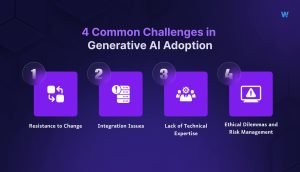
Adopting generative AI offers transformative potential for businesses, yet it comes with several challenges. Understanding these obstacles and implementing practical solutions is crucial for successful integration.
- Resistance to Change
Challenge: Employees and stakeholders may be hesitant to embrace AI technologies due to fear of job displacement or a lack of understanding.
Solutions:
- Education and Training: Conduct workshops and training sessions to demystify AI, highlighting its role as a tool to augment human capabilities rather than replace them.
- Inclusive Implementation: Involve employees in the AI adoption process, seeking their input and addressing concerns to foster a sense of ownership and acceptance.
- Integration Issues
Challenge: Incorporating AI systems into existing workflows and legacy systems can be complex and resource-intensive.
Solutions:
- Collaborate with Integration Specialists: Partner with startups and firms specializing in AI integration to bridge the gap between new technologies and existing systems.
- Phased Implementation: Adopt a step-by-step approach, gradually integrating AI components to monitor performance and make necessary adjustments without overwhelming the system.
- Lack of Technical Expertise
Challenge: A shortage of skilled professionals can hinder the effective deployment and management of AI technologies.
Solutions:
- Invest in Talent Development: Provide continuous learning opportunities for existing staff to upskill in AI-related fields.
- Leverage External Expertise: Engage consultants or AI service providers to access specialized knowledge and facilitate knowledge transfer to internal teams.
- Ethical Dilemmas and Risk Management
Challenge: AI systems can inadvertently perpetuate biases, raise privacy concerns, and lead to over-reliance on automated processes.
Solutions:
- Establish Ethical Guidelines: Develop and enforce policies that promote responsible AI use, ensuring data privacy and mitigating biases.
- Maintain Human Oversight: Ensure that AI complements human judgment, particularly in critical decision-making processes, to prevent over-reliance on automation.
- Regular Audits: Conduct periodic evaluations of AI systems to identify and rectify biases or errors, maintaining transparency and trustworthiness.
Quick Tips for Small Businesses and Startups to Adopt Generative AI
Adopting generative AI can be both cost-effective and straightforward for small businesses. Here’s how you can dive in:
- Define Clear Goals: Start with a clear vision for how AI can enhance your business—whether it’s streamlining content creation or improving customer interactions.
- Opt for Budget-Friendly Tools: Explore affordable generative AI platforms like OpenAI GPT, Jasper, or Lumen5 to help with automation and content generation.
- Start Small: Pilot AI in one area, such as automating customer service or creating social media posts, before scaling it across other functions.
- Use Pre-trained Models: Skip the heavy lifting by using existing models and frameworks, such as those from Google AI or Hugging Face, to reduce development costs.
- Partner with Experts: Collaborate with professionals who can guide your AI integration without hefty investments in building internal expertise.
How Wow Labz Can Make Your Generative AI Journey Smoother
At Wow Labz, we understand the unique challenges faced by small businesses in embracing generative AI. Our goal is to make the adoption process seamless, effective, and affordable, while ensuring that your company stays ahead of the curve.
- Generative AI Development: We build custom Generative AI solutions that are designed to automate your tasks, freeing up your time and improving efficiency.
- Cloud Implementation: Our AI solutions are cloud-based, ensuring scalability and reducing overhead costs, so your business can grow without the extra infrastructure burden.
- Turnkey Product Development: We offer end-to-end services from ideation to launch, powered by AI to optimize every step of the process.
- AI Integration: Seamlessly integrate generative AI into your current workflows and watch your business transform without disruptions.
What truly sets us apart is our ability to deliver innovative and agile solutions that match the pace of your business. Whether you’re building a new venture or reimagining an existing brand, we’re here to provide tailored solutions that help you thrive in a rapidly evolving digital landscape.
Conclusion
Generative AI is more than just a tool—it’s a game-changer for creative ad agencies. From streamlining workflows to delivering hyper-personalized campaigns, its transformative potential is undeniable. But here’s the thing: success with AI isn’t just about the technology—it’s about how you use it.
As a creative professional, think of AI as your ultimate collaborator. It can help you brainstorm, optimize, and execute ideas faster than ever, leaving you more time to focus on what really matters: crafting campaigns that connect with audiences on a deeper level.
Need help bringing your AI project to life? Contact us to take the first step towards innovative AI-driven solutions tailored to your needs.

